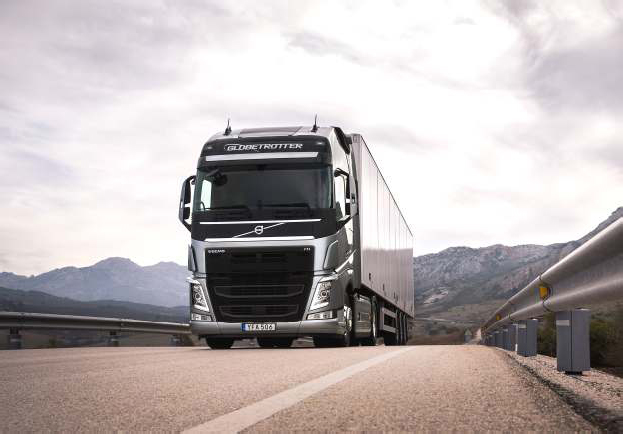Volvo FH with l-save rolls out in Europe
The global truck manufacturer founded in Sweden says its new truck model will cut fuel costs by up to 7 percent
Volvo FH with I-Save is our answer to this challenge. It is a complete solution that combines our latest technology to substantially bring down fuel consumption in long-haul operations. And this is without compromising drivability,” said Roger Alm, President of Volvo Trucks.
In the trucking industry, fuel accounts for the biggest single expense of any trucking company at nearly 40 percent, with about 20,500 gallons of fuel consumed per commercial truck on average in one year, according to studies. Add to that are costs related to maintenance, repair, insurance, among others.
If fuel prices are on the rise, that puts a dent on company revenues, which also often lead to increased costs for consumers, especially in the freight industry.
The emergence of electric and hybrid trucks offering lesser fuel costs, maintenance expenses and lower CO2 emissions are, thus, a welcome relief for the global trucking industry, especially in Europe where more stringent environmental regulations must be followed.
The Volvo FH with I-Save
In March, Volvo Trucks rolled out for orders for the first time in Europe the Volvo FH with I-Save which the global Sweden – based truck manufacturer pledges to scientifically cut fuel costs y up to 7 percent in long – haul operations without compromising drivability.
Volvo said this model was designed to answer the customers clamor for more fuel efficient trucks, especially during winter.
 The company said the demand for transportation across Europe is growing and trucks are covering increasingly longer distances while transport operators are faced with rising diesel prices putting pressure on profitability.
The company said the demand for transportation across Europe is growing and trucks are covering increasingly longer distances while transport operators are faced with rising diesel prices putting pressure on profitability.
“Volvo FH with I-Save is our answer to this challenge. It is a complete solution that combines our latest technology to substantially bring down fuel consumption in long-haul operations. And this is without compromising drivability,” said Roger
Alm, President of Volvo Trucks. At the core of Volvo FH with I-Save is the new, state-of-the-art D13TC – Volvo Trucks’ most fuel-efficient long haul engine to date. It features pistons with a patented wave-shaped interior that improves combustion and increases efficiency by guiding heat and energy to the centre of the cylinders.
Excess energy in the exhaust gases is then used to power the engine through an additional turbine in the exhaust flow, called the Turbo Compound unit.
The D13TC engine produces up to 300 Nm extra torque, which means less acceleration and fuel is needed to keep a steady speed in highway traffic. It is the ideal solution for long- haul customers.
Engineered for long haul driving
Other features of I-Save include new fuel-efficient rear axles, an updated map-based I-See system that analyses and adapts to gradients ahead and includes gear-shifting software optimised for long-haul applications.
The combined efficiency gains of all these products and services can result in fuel-cost savings by up to 7% compared to a D13 Euro 6 Step D engine.
“We have tailored every aspect of I-Save to suit long-haul operators, especially those that typically drive more than 120,000 km per year,” said Mats Franzén, Power train Strategy Director at Volvo Trucks. “The longer they drive, the more they can potentially save. It is a powerful engine which delivers a highly fuel efficient and smooth driving experience.”
EU to regulate CO2 emission from heavy duty vehicles
 Responding to the E U ‘ s decision to regulate C O 2 e missions from heavy-duty vehicles, Volvo said it continues to invest heavily in more climate-friendly transport solutions. But, it cautioned, additional measures are needed to stimulate demand for vehicles with low CO2 emissions.
Responding to the E U ‘ s decision to regulate C O 2 e missions from heavy-duty vehicles, Volvo said it continues to invest heavily in more climate-friendly transport solutions. But, it cautioned, additional measures are needed to stimulate demand for vehicles with low CO2 emissions.
“Cutting climate emissions from heavy-duty vehicles is an incredibly important task, and it’s fundamental to our initiatives in sustainable transport. At Volvo Trucks, we’re well-positioned to take on this challenge. It’s natural for the EU to now introduce limits on CO2 emissions. In order to speed up the transition, we would however also like to see stronger financial incentives for the customers who take the lead and choose more climate-friendly vehicles,” said Alm.
Volvo Trucks said electric trucks can contribute to reducing CO2 emissions. It launched its first truck models with electric powertrains in 2018 and will start series production this year.
 “We’re at the stage where the technology will soon be ready for wider applications in heavy-duty transport. If demand is stimulated and the new charging infrastructure network is expanded, the volume will also be able to increase at a faster rate than would otherwise be possible,” said Lars Mårtensson, Director of Environment and Innovation at Volvo Trucks.
“We’re at the stage where the technology will soon be ready for wider applications in heavy-duty transport. If demand is stimulated and the new charging infrastructure network is expanded, the volume will also be able to increase at a faster rate than would otherwise be possible,” said Lars Mårtensson, Director of Environment and Innovation at Volvo Trucks.
Other climate solutions include natural gas and biogas. Running a Volvo FH LNG on natural gas cuts CO2 emissions by about 20 percent compared to diesel. With biogas, the tank-to-wheel emissions can be cut by 100 percent.
At the same time, Volvo Trucks is continuing to develop the diesel trucks that currently make up the absolute majority of its sales.
Since the early 1990s, the fuel usage and CO2 emissions of a typical long-distance Volvo truck have decreased by about 20 percent, and there is room for additional improvements with more efficient power trains, lower rolling resistance, and better aerodynamics. Each truck needs to be optimized for its specific transportation task.
While the emission limits imposed by the EU set a clear timetable for vehicle manufacturers, the goal – improving fuel efficiency and reducing the climate impact – has been a top priority for the industry for some time now, in part because fuel usage makes up about one-third of the costs for a transport company.
“Our ambition has always been to be able to offer our customers the optimal, energy efficient comprehensive solution for the transport task at hand,” said Mårtensson.
“New technologies that contribute to cutting CO2 emissions need to be able to enter the market rapidly. Fasttracking the reviewing and certification process by the authorities would speed up the introduction of new innovations within the transport sector,” he added.
Every feature of I-Save has been designed to cut fuel costs. Included in the Volvo FH with I-Save:
- D13TC (Turbo Compound) 460 hp (2 600 Nm) or 500 hp (2 800 Nm) engine
- New, highly fuel-efficient rear axles
- Engine idle shutdown
- I-Cruise with I-Roll, which adjusts speed to keep down fuel consumption
- Power Steering Pump with Variable Displacement
Updated I-See - Updated I-Shift with long-haul optimized software
- Source: www.volvotrucks.com














